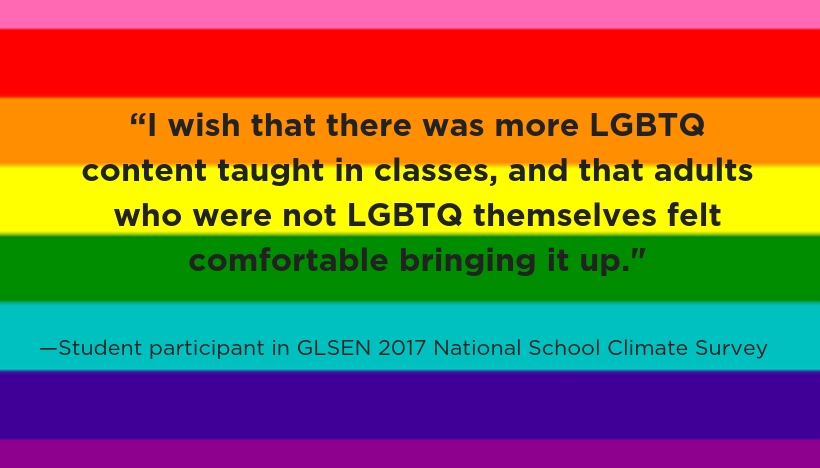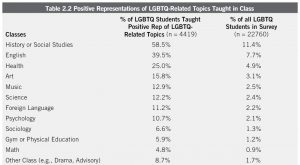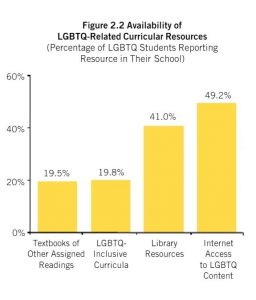GLSEN just came out with its 10th National School Climate Survey measuring the experiences of lesbian, gay, bisexual, transgender, and queer youth in our nation’s schools. Three findings apply to English language arts teachers
•
Approximately 1 in 5 LGBTQ students were taught positive representations of LGBTQ people, history, or events in their classes. Nearly the same amount had been taught negative content about LGBTQ topics.
• Most students did not have access to information about LGBTQ-related topics in their school library, through the internet on school computers, or in their textbooks or other assigned readings.
• Almost all students could identify at least one school staff member whom they believed was supportive of LGBTQ students. Just over a third (38.8%) could identify many (11 or more) supportive school staff (p.55)
Findings in the survey are commensurate both with the numbers of LGBTQ+ books that made the Top Ten Most Challenged List last year and with NCTE’s Diverse Gender Expression and Gender Non-Conformity Curriculum in English Grades 7-12, which reminds us that
An equitable focus on issues honoring a range of diverse expressions related to gender and gender non-conformity in the ELA classroom is necessary to meet all students’ needs and to help all students develop complex ways of understanding gender. . . . Because gender equity is a universal issue, it is imperative that English language arts educators develop a lens through which they can see and think critically about gender, gender expression, sexuality, and non-conformity. Through this lens, students would consider how gender and sexuality are represented in a range of texts; would gain awareness regarding gendered and heteronormative expectations gender; would work with texts featuring a diverse range of people (including those who are LGBTQ and/or gender non-conforming); and would express their own perspectives regarding these representations and expectations.
How do we as teachers ensure that our LGBTQ+ students — that ALL students — are receiving positive representations of LGBTQ+ people in the literature we use in our courses? The following blogs provide a wealth of ideas:
An LGBTQ+ Identity Toolkit for Educators by sj miller.
“We’re living in scary and challenging times as educators. Issues connected to LGBTQ+ people have been brought into a heightened focus in the news, and this means it has never been more urgent for these issues to be folded into conversations within our schools and classrooms. But many teachers find themselves ill-equipped and ill-prepared to guide these discussions and meet the myriad emergent needs of their students in this space. That’s why I’m excited to share a new set of resources I’ve helped to create with you.”
Why We Need to Talk about Gender in Our Teaching by Millie Davis
“English language arts classrooms can be significant sites for combating homophobia and heterosexism in schools, and reading LGBT-themed literature is one of the best ways to do this work.”
Using Literature to Advocate for Queer Kids and Their (Potential) Allies by Mollie Blackburn
“I am one among many who have called for bringing LGBTQ-themed literature into English language arts classrooms and queering literature already there.”
Legacy of Pride: We Are Decidedly Not Other; We Are Teachers; We Are One by Jocelyn Chadwick.
“I have had the pleasure of marveling at how bringing LGBTQ perspectives, issues, and ideas to texts resulted in engaging classrooms and pushing students and me to expand our thinking. Thanks to the real and substantive commitment and support of organizations like NCTE, the “traditional” ELA classroom has been transforming into a living-literacy laboratory. We have come to expect that this space be reflective of our diverse human tapestry. We have come to expect that classrooms become places where all student voices are encouraged and welcomed, places where our LGBTQ students know they are safe and supported—instructionally and emotionally.”
Making a Safe Space for LGBTQ Texts into Your Classroom by Millie Davis.
“It is one thing to say that teachers should be reading books with LGBT characters or themes with their students, but it can be quite another to actually do it, especially in contexts that might not feel supportive. To assist teachers who are stepping into unfamiliar waters,” Jill Hermann-Wilmarth and Caitlin L. Ryan have recommendations.
“We must work for social justice–the questioning and eventual reconstructing of these systems. Though there is much we do not know about the tragedy in Orlando, it is clear that healing, understanding, acceptance, and dialogue are needed to create a society and world where all people are safe and valued.”
Resources for Teaching in These Times
Find a long list of policies, articles, and ideas.



